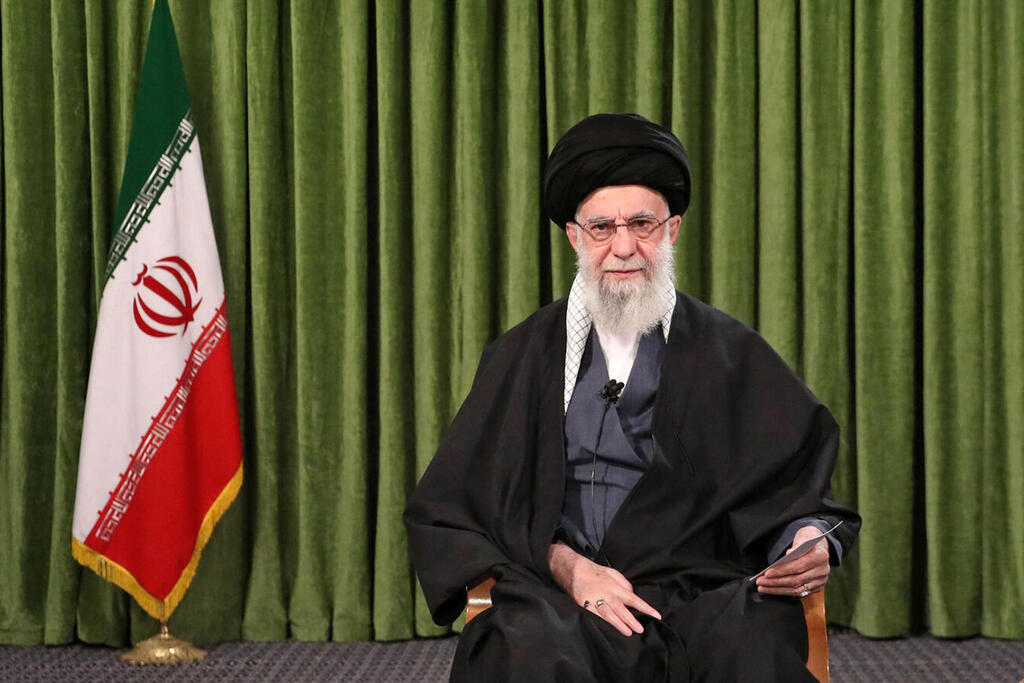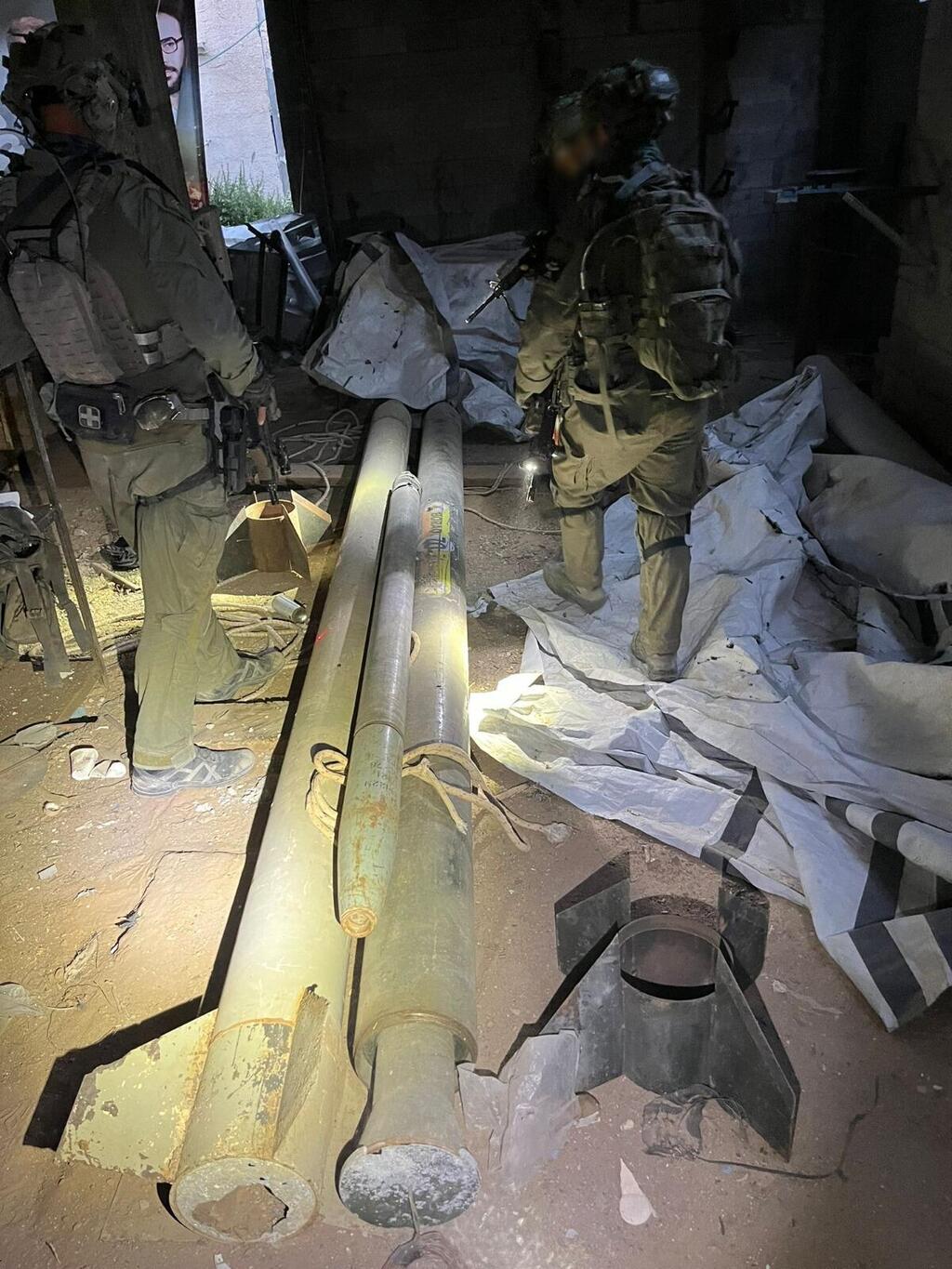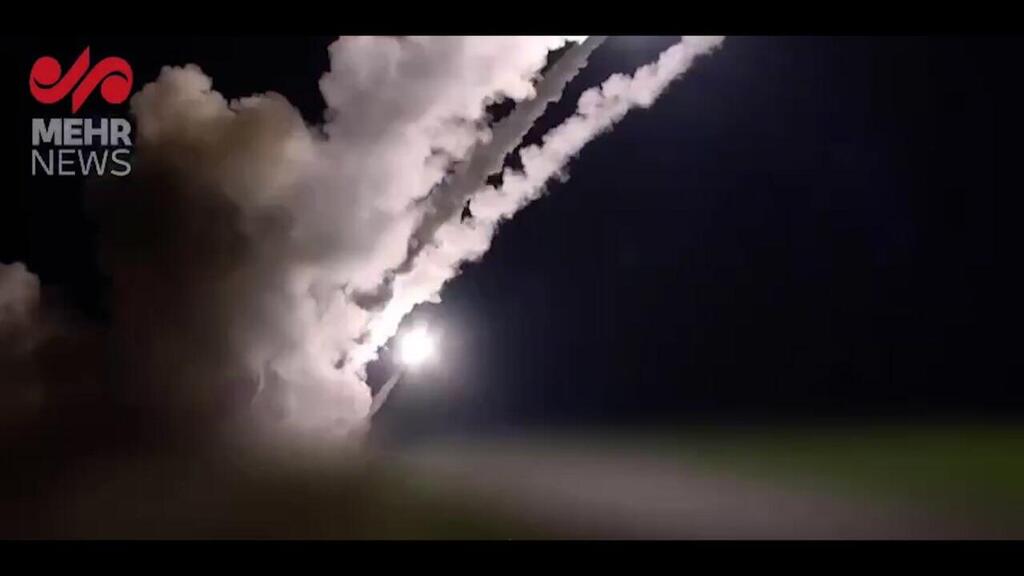Iran is spending billions of dollars to enact a four-part strategy to dominate the Middle East. The plan has been in place for years and is now showing clear-cut results.
On September 26, 2020, Commodore Ali Fadavi, the deputy commander of the Islamic Revolutionary Guard Corps (IRGC) — the regime’s sponsor of non-state armed groups — provided some figures about Iran’s effort to erect a "Resistance Front" to confront Israel and oust the United States from the Middle East.
Interviewed on Iran’s state TV channel Ofogh, he was asked, “From the beginning, when we got involved in the Resistance Front, how much do you think we spent? The numbers are very low, a lot less than the war (with Iraq which he put at $19.6 billion between 1980-1988) but the results (have been significant)."
8 View gallery


Iran spent more than $16 billion on support for the Assad regime
(Photo: EPA/ABEDIN TAHERKENAREH)
Of course, this and many other statements of Iran’s officials must be taken with great skepticism. For example, Iranian lawmaker Heshmatollah Falahatpisheh was quoted by Iran’s media in May of that year as saying that Tehran might have spent between $20 billion and $30 billion just on its involvement in Syria, where Iranian-backed forces and militia have propped up the regime of Syrian President Bashar al-Assad.
The U.S. State Department estimated that Iran spent more than $16 billion on support for the Assad regime and its proxies between 2012 and 2020. In 2018, the U.S. Treasury disclosed that Hezbollah had been receiving $700 million a year from Iran, making up 70% of the terrorist army’s revenues.
Similarly, Yahya Sinwar, the Gaza head of Hamas, declared in 2017 that “Relations with Iran are excellent, and Iran is the largest supporter of the Izz ad-Din al Qassam Brigades (Hamas’s military wing) with money and arms.”
In a 2022 interview with Al Jazeera television, Hamas politburo chief Ismail Haniyeh supposedly clarified that his terrorist group had received $70 million in military help from Iran. "We have locally manufactured rockets but the long-range rockets came from abroad, from Iran, Syria, and others through Egypt," he added.
What Iran accomplishes through these malign 'investments'
However, like Iran, Hamas is likely manipulating the data. For example, in 2020, the U.S. State Department concluded that Iran had provided more than $100 million annually to Hamas and Palestinian Islamic Jihad. However, an Israeli “security source“ was quoted by Reuters on October 13, 2023, as indicating that Iran had significantly increased funding for Hamas' military wing “in the past year” from $100 million to about $350 million a year.
Whatever the exact figures, this question naturally arises – what did Iran accomplish through these malign “investments?"
The short answer is that Iran’s money financed a highly productive strategy to project its power in the Middle East at the expense of Israel and the United States. The goal is twofold— by carving a zone of influence, the Islamic Republic is seeking to protect the Shia regime from the surrounding Sunni-dominated countries.
Iran’s money financed a highly productive strategy to project its power in the Middle East at the expense of Israel and the US. By carving a zone of influence, the Islamic Republic is seeking to protect the Shia regime from the surrounding Sunni-dominated countries
It is also bent on exporting its Islamic Revolution in line with the ideology of its founder Ruhollah Khomeini, who wrote “We export our revolution to the whole globe because our revolution is Islamic, and until the call of ‘No god but Allah, and Mohammad is Allah’s prophet’ is not reverberated throughout the globe there will be struggle, and until the struggle against the arrogant is found all over of the globe, we will be standing.”
Under this vision, which is also codified in the Iranian constitution, there is simply no place for Israel or the U.S. in the Middle East.
To carry out this decree Iran has increasingly used four elements in the pursuit of its grand design:
Proxy war
The use of proxies in war is a practice with long historical roots. The Iranian innovation in this respect is not only the development of multiple proxy forces spread over a large geographical area, but also intensive effort to coordinate between them so they can collaborate operationally during conflict.
Today, Iran can boast of its proxy forces operating in Gaza, Lebanon, Syria, Iraq and Yemen. Increasingly, there are signs of two other Iranian-sponsored fronts emerging in the West Bank and Jordan. All these fronts are involved in attacks on Israel and some are also fighting to eject the U.S. from the Middle East.
Iran’s proxies have been built up as a deterrent vis-a-vis Israel and the U.S. Hezbollah especially serves as Iran’s “second-strike force” in case Israel dares attack its nuclear installations
Iran is using its proxies in two main capacities. First, these terrorist formations are the driving force behind the forging of its regional geopolitical construct. They are also meant to impede any attempt to interfere with Tehran’s sinister design as it is being erected.
As Iran’s Supreme Leader Ayatollah Ali Khamenei put it on June 3, the Hamas October 7 onslaught on Israel had happened exactly at the moment the region needed it, when there had been a plan “by the U.S., Zionist individuals, their followers and some of the region’s countries to change the equation in the region… Operation Al-Aqsa Flood [Hamas’ codename for the October 7 attack] disrupted the Zionist regime’s comprehensive plan to dominate the politics and economy of the entire region of West Asia, and there is no hope that they will be able to revive this plan.”
Interestingly, the Palestinian Authority Presidency indirectly confirmed Iran’s proxy strategy of using other agents for its own purposes when it denounced Khamenei's comments the same day. It issued a statement saying that the Palestinians “are the first to be affected by this war (in Gaza) which has shed their blood” and that Khamenei’s comments “clearly announce that (Iran’s_ goal is to sacrifice the blood of Palestinians and to destroy Palestinian land.”
Secondly, Iran’s proxies have been built up as a deterrent vis-a-vis Israel and the U.S. Hezbollah especially serves as Iran’s “second-strike force” in case Israel dares attack its nuclear installations.
However, given the current intensification of Hezbollah’s attacks on Israel’s north and the marked increase in the chances of full-scale war breaking out, this deterrent function could be transforming. The escalation may indicate Iran now believes its own capabilities are sufficient to dissuade Israel from such an “adventure”. Alternatively, Tehran may have concluded that after October 7, Israel is no longer the threat it once was especially as it is preoccupied militarily on several fronts.
As Khamenei said on June 3, “An army (the IDF) which once claimed to be one of the world’s strongest armies has been defeated by groups from Hamas and Hezbollah while trying to guard itself in the south and the north.”
Strategic advantage
Importantly, the use of proxies is not only for the purpose of shielding Iran from possible retribution and affording the mullah's deniability. The maneuver provides a strategic advantage. Proxy use allows Iran to flaunt the rules of war while shirking responsibility as those doing the actual fighting are “autonomous” subnational groups.
The targets of this strategy, which are uniformly states, are in turn confronted with another difficulty associated with engaging in asymmetric warfare. Accordingly countries, especially those signed on to the 1949 Geneva Conventions, are expected to follow the rules of war even when fighting terrorist armies even though the latter are bound by no such commitment.
8 View gallery
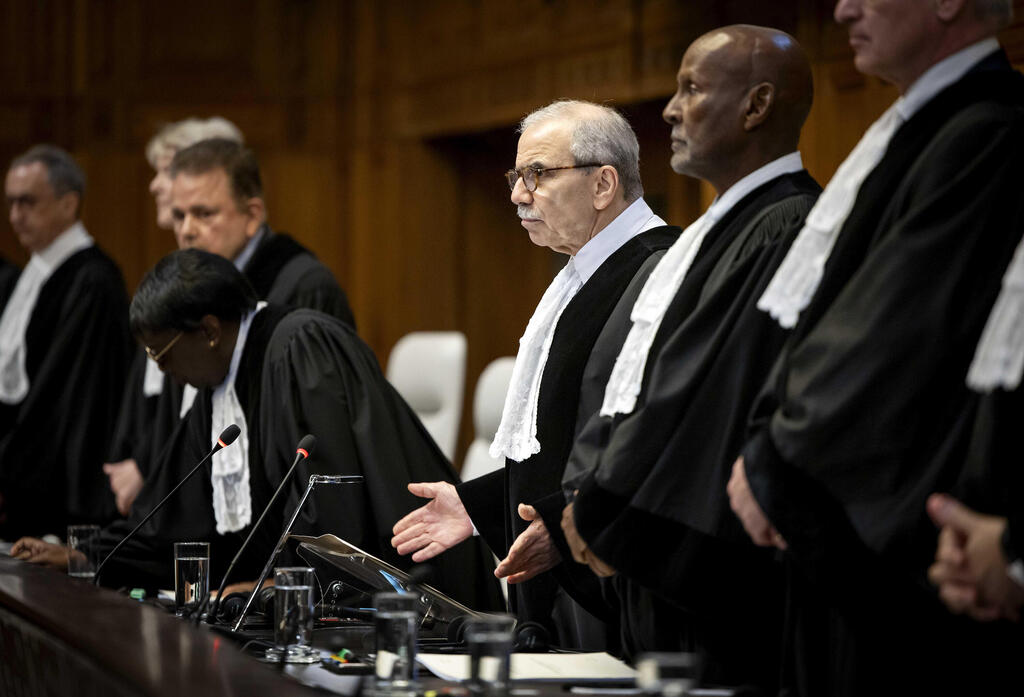

They hope that their opponents become the subject of international censure and possible sanctions. International Court of Justice, Haugh
(Photo: EPA/Koen van Weel)
Moreover, these “armies,” by embedding themselves among civilians and using non-military facilities as launching pads to conduct attacks, deliberately challenge their opponents to breach the rules if they counterattack. They hope that their opponents become the subject of international censure and possible sanctions that would impede their operations.
Iran's use of proxies extends beyond the Middle East. For example, in a warning posted by Israel’s Mossad intelligence agency on May 30, ahead of the Paris Olympics, it was disclosed that Iran frequently uses criminal organizations in Europe and elsewhere to carry out strikes on its behalf “to try to hide its hand in the attacks.”
In addition, Mossad said that Iran is trying to take advantage of the wave of global antisemitism relating to the war in Gaza to “recruit a variety of new kinds of proxies to carry out its terror attacks globally.”
Primitive warfare
While Israel has been spending billions on the acquisition and development of ultra-tech weapons to maintain the IDF’s “qualitative superiority,” Iran, operating under severe international sanctions, went the opposite way. It opted to engage in low-tech warfare both in terms of tactics and weaponry. In effect, what is unfolding currently in the Middle East is a veritable test of the familiar quantity vs. quality contest.
Operationally, Iran’s strategy is based first and foremost on the seemingly unending supply of “shahids” (martyrs) who are ready, either as true believers or because of mercenary motives, to wage jihad. Armed mostly with cheap personal weapons (e.g. AK-47s, RPGs, IEDs, etc.) they are backed by similarly rudimentary “strategic“ weapons like drones, “dumb” rockets, anti-tank guided missiles mortars, and (mostly) low-accuracy (or statistical) heavy ground-to-ground missiles. Mobility is provided by Toyota pickup trucks, motorbikes and hand gliders. The armaments are procured en masse so that, while unable to defeat the enemy, the combination of seemingly inexhaustible manpower and firepower can attrite it over time.
For example, aiming “strategic” arms at civilian population centers is carried out with the clear knowledge that while the damage they inflict directly is often marginal, the fallout these low-tech weapons cause in terms of interrupting ordinary lives in the target communities is consequential.
Aside from their tactical futility, the firings of such rockets and missiles often trigger a powerful response, yet the continued launching of these weapons is meant to signal an unyielding readiness to fight to the finish and be undeterrable despite the power imbalance. The aim is to cause desperation among the enemy ranks as it faces an unending conflict.
Indeed, IDF soldiers fighting in Gaza have discovered Iranian-supplied Russian-made rockets with their safety mechanism disabled to enable attacks on IDF soldiers from short range. True to form, the practice is prevalent even though the removal of the safeguard endangers the operator, and the attacker is often quickly eliminated.
A derivative of the primitive warfare concept is the underground dimension of the conflict which is designed to overcome the dramatic asymmetry in the above-ground capabilities. In essence, the aim is to turn the subterranean theater of operation into the central battlefield to improve the odds against the IDF.
Gigantic military fortress purpose-built to attack Israel
According to the New York Times on January 16, 2024, Israeli defense officials estimated that Hamas’ tunnels in the Strip measure between 350 and 450 miles (560 and 720 km) in a territory that’s just 25 miles long. By comparison, the London Underground is only 249 miles long. Some of Gaza’s tunnels are wide enough for cars; some are more than 150 feet deep; some serve as munitions depots; others are comfortably command bunkers designed to withstand a prolonged war.
Israeli officials also reportedly estimate that there are 5,700 separate entrances to the tunnels — many of them with access from civilian houses and some directly beneath hospitals, which in some cases were also used as a Hamas command center, according to U.S. intelligence.
The tunnels investigated by the soldiers of the Yahalom Unit in Jabaliya
(IDF)
In total, Hamas has turned the Gaza Strip into a gigantic military fortress purpose-built to attack Israel, endure Israeli retaliation, and interpose civilian lives and infrastructure as part of its means of defense.
Hezbollah, Iran’s main proxy is believed to have a similarly extensive tunnel network if not a more elaborate one.
Further, the principle of quantity over quality also inspires the Iranian strategy of confronting Israel with a multiplicity of “resistance fronts” both above and underground. The fronts encompass myriad forms with the overarching objective of toppling Israel, including by targeting its links to its strategic allies.
An open letter dated May 25, from Iran’s Khamenei to students protesting the Gaza war on U.S. campuses, attests to the Iranian strategy of seeking to proliferate the number of fronts aimed to undermine Israel’s superiority, including by subverting its sources. Khamenei wrote the students have “now formed a branch of the Resistance Front (against) the brutal Zionist terrorist network…”
Hijacking the rules of war
The Western-crafted rules of warfare are the cornerstone of the Islamist battlefield tactic which systematically uses them to its advantage. It is unclear to what extent Islamists break the rules of warfare as an indication of their general rejection of the Western “world” or because of tactical necessity given the asymmetry in the military balance. Still, it is indisputable that Iran-sponsored jihadist armies like Hamas and Hezbollah take the Western norms of conflict as signaling their enemy’s weakness and irresolution if not downright dimwittedness.
As long as the enemy adheres to the canons of war, the “resistance” can leverage the same rules as force multipliers. If, on the other hand, the rules are breached, they are hoping for an international outcry that would force a halt to military operations
As the Gaza campaign and the ongoing attrition war against Hezbollah have proven any notion that the IDF’s military superiority can afford such giveaways is sorely mistaken and ends up costing soldiers’ lives. On the contrary, the self-imposed restraints exercised by the IDF are exploited by its Islamist enemies as a “strategic equalizer” that bolsters their chances vis-a-vis a formidable opponent.
Indeed from the Islamists’ perspective, it is a win-win situation. As long as the enemy adheres to the canons of war, the “resistance” can leverage the same rules as force multipliers. If, on the other hand, the rules are breached, which is almost inevitable given the terrorist armies’ favorite tactic of using the population as human shields, they are hoping for an international outcry that would force a halt to military operations. The pause is invariably used to regroup and rearm for another try.
Thus, in their strategy, Iran’s terrorist armies take full advantage of the laws of warfare applying only to sovereign states. The IDF’s prolonged campaign in Gaza in the pursuit of “demolishing Hamas’ military capabilities” could thus be an important test of a counter-strategy, if realized.
8 View gallery
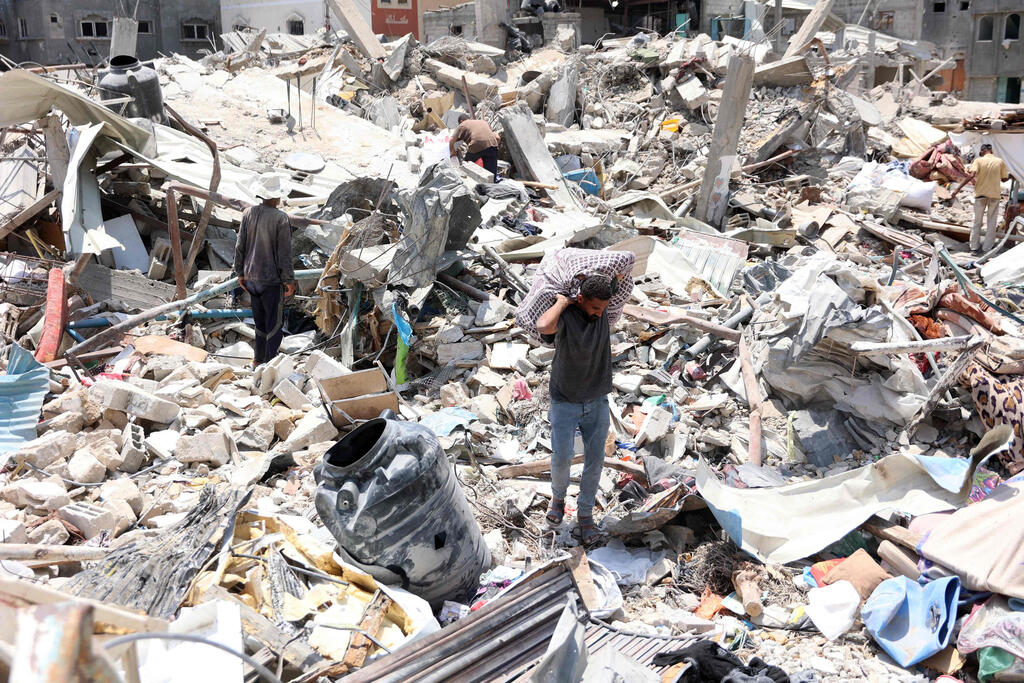

The results of Hamas embedding among the civilian population
(Photo: Omar Al Qatta / AFP)
In addition to the October 7 attack itself, which in large measure specifically sought to massacre non-combatants of all ages and was also purposely aimed to terrorize the population, there is hardly a civilian site in Gaza that had not been used by Hamas to facilitate its fight against Israel. Hospitals, mosques, schools, buildings, apartments, and parks were all weaponized en masse.
Given this systematic militarization, it will not be an exaggeration to conclude that the rules of warfare, through their wholesale and deliberate upturning, provided the basis for Hamas’ battlefield “doctrine” and for turning the entire Gaza Strip into a terrorist encampment both above and underground. Paradoxically, this also indicates the IDF’s adherence to the rules, otherwise, the entire Hamas posture of embedding among the civilian population would have come to naught even if conceived.
Indoctrination for martyrdom
This is perhaps the most important principle as it is designed to assure the unending pursuit of the goals irrespective of cost. Simply put, confronting superior military forces like the IDF without the religious-ideological indoctrination of its adherents would normally not be even conceived, let alone tried. In effect, what terrorist armies lack in armaments and professionalism, Iran is supplanting with motivation aimed to generate zealousness and undeterrability.
In line with this reasoning, the IRGC trains recruits and Shia militias in an expansionist and combative worldview, encouraging them to give their lives in pursuit of a cause that purportedly seeks to correct injustices toward Muslims beyond Iran’s borders.
8 View gallery


Khamenei called on American students protesting the Gaza war on their campuses to “become familiar with the Quran.”
(Photo: Alex Kent / GETTY IMAGES NORTH AMERICA / AFP)
As Khamenei himself wrote in 2016, “If in the Revolutionary Guard there is not strong ideological-political training, then (the) IRGC cannot be the powerful arm of the Islamic Revolution.”
The Iranian leader must have been satisfied when he heard Hussein al-Mousawi, a spokesperson for Nujaba, one of Iran’s proxies in Iraq, telling Reuters on June 4, ”We, as a resistance, do not fear the consequences as long as we are in the right…”
From the outset, the fight against Israel and the West in general is cast in religious terms as a war against infidels who wronged the Islamic nation (Ummat al-Islam). Khamenei's comments immediately following the October 7 monstrosity summed up the crux of this thinking thoroughly when he said the attack “shows the power of Islam.”
Not surprisingly he also called on American students protesting the Gaza war on their campuses to “become familiar with the Quran.”
Victimhood is celebrated
The Iranian power projection strategy exhibits a deep appreciation of the psychological dimension of the fight both in terms of one’s own “troops” and the stamina of the enemy. Consequently, Iran’s proxy attacks seek entirely different aims than the military objectives pursued by Israel and other Western opponents. While the IDF and modern armies in general aim to destroy an enemy’s ability to fight, Islamists are fighting to undermine Israelis’ will to fight. In turn, primitive weapons that inflict indiscriminate damage are not only sufficient but preferable as they are meant to terrorize the civilian population.
Special attention is given to galvanizing the “Shahids” and intimidating the enemy. It starts with Hamas and Hezbollah terrorists wearing headbands often citing Quranic verses, which in effect turn them into crusaders fighting a holy war under the banner of Islam. Almost all attacks carried out by Iran’s proxies, including those by Iraq’s Kataib Hezbollah and Nujaba, as well as the Houthis in Yemen, are videotaped, with the terrorists heard shouting Allahu Akbar (God is greater) or the names of holy figures revered mainly by Shi'ites. The videos are quickly disseminated through social media to impress Tehran and accentuate the triumph of the resistance and the feebleness of the “oppressors.”
Victimhood is celebrated and numbers of dead and wounded are often fabricated to accentuate sacrifice and stoke the fires of hate toward the “occupiers of al-Aqsa.” The goal is to mobilize the population and assure its commitment to the cause.
Khamenei, in fact, told Hamas’ Haniyeh during their meeting in Tehran on March 26, “The propaganda and media activities of the Palestinian resistance have been very good so far, and ahead of the Zionist enemy [Israel], and more action should be taken in this field.”
The actual material impact of any attack on Israeli targets is secondary to demonstrating unstoppable resistance. After Iran’s unprecedented massive missile and drone attack on Israel on April 14, Khamenei reportedly said “How many missiles were launched and how many of them hit their target is not the primary question, what really matters is that Iran demonstrated its power during that operation.”
Yet, hitting hi-tech targets and those symbolizing the prowess of the IDF (e.g. Merkava tanks or hi-tech intelligence gathering installations and sophisticated drones) is a priority. The message is that these assets are just a façade of power and will not bring victory or stand up to the warriors of Allah on his divinely mandated missions.
In this vein, the introduction by the Israeli army of some robotic-operated weapon systems, specifically the unmanned M-113 armored personnel carriers (APC), into the Gaza war to transport explosives, was propagandized as evidence of its soldiers’ cowardice. Accordingly, the use of robots signifies an IDF attempt to evade a direct engagement with the “gallant soldiers” of Hamas.
Iranian regime reduces presence in syria
(ILTV)
On May 31, the military spokesperson of the Houthis in Yemen Brig. Gen. Yahya Saree claimed his forces launched a missile attack in the direction of the U.S. aircraft carrier Eisenhower in the Red Sea in response to U.S. and British strikes on Yemen. The fact that a U.S. defense official told Reuters they were not aware of any attack on the Eisenhower is, of course, utterly immaterial. The aim is to convince the believers and their enemies of the power of the “resistance” and its endurance regardless of the odds, as well as to demonstrate the flimsiness of the “usurping oppressors” most powerful weapons.
After all the Houthis official slogan is “Death to America/Death to Israel/Curse Upon the Jews/ Victory to Islam.”
The culmination of this psychological warfare is the routine of posting a “victory photo” involving shooting at an IDF position or the firing of some leftover rocket at an Israeli community after the fighting had been concluded. While outsiders may scoff at the practice, Iran’s Islamist “armies” are unflagging in their determination to use the practice to “prove” they had won the engagement even if the act itself causes little damage and a harsh Israeli reprisal is forthcoming. The idea is to communicate to various audiences that a superior force like the IDF is, in fact, incapable of defeating the “resistance,” let alone defending Israel. Given the immense power imbalance, terrorist armies are fully aware that to claim victory they only need to survive (usually with the help of third powers.)
Clearly, Iran and its Islamist proxies are heavily reliant on propaganda and indoctrination as a central element in their arsenal. It is a critical component meant to compensate for their military deficiencies when it comes to confronting a powerful enemy like Israel and which an activist power projecting strategy would normally require.
As a testimony to their manipulative and deceitful practices, Islamists do not rely solely on indoctrination, however. Just in case the martyrdom glorifying doses proved an insufficient motivator, the addictive, synthetic amphetamine-type stimulant captagon, known as the “Islamic State drug,” was reportedly used by jihadists to prevent fear and fatigue during fighting in Syria and Iraq. Hamas terrorists who carried out the October 7 massacre were found to be under the influence of the drug with pills of captagon having been recovered from the pockets of many who were killed inside Israel.
The bottom line
It must be recognized that Iran has developed a successful strategy to carve for itself an expanded zone of influence in the Middle East. In effect, the Islamic Republic has already captured four Middle Eastern countries — Lebanon, Syria, Iraq, and Yemen — since it took power in 1979–all without itself engaging in war.
Still, Iran’s regional scheme may now face its first real test. In the wake of October 7, Israel, through its wars against Hamas and Hezbollah, is effectively threatening to block and possibly roll back the entire Iranian geopolitical design. Israel is currently acting to dismantle the tangible aspects of Iran’s power projection strategy, which are being overtly employed to not only devastate the Jewish state but are hyped as a means to escalate and broaden the “resistance.”
However, winning the conflict, as opposed to winning the war against Iran, cannot be accomplished unless Israel effectively confronts the religious-ideological dimension of the struggle as well. Victory will certainly not be achieved as long as the IDF continues to act contrarily and enshroud its operational successes, especially in the north, out of concern that advertising its accomplishments would force Hezbollah’s hand.
 Avigdor Haselkorn
Avigdor HaselkornAlthough it is perhaps the most challenging task, the draw of countering systematically the “soft” power component of Iran’s sinister grand design is its potential to destabilize the mullah regime itself. Moreover, pursuing such a perception-management campaign across the region would not be affected by the vagaries often associated with the U.S. elections’ schedule.
Yet time is of the essence. In the absence of a comprehensive Israeli strategy to defeat the Iranian grand scheme, Khamenei's June 3 boast that “the Zionist regime is gradually melting before the eyes of the people of the world,” could become sufficiently convincing for the mullahs to try and deliver a coup de grace to the Jewish state.
- Dr. Avigdor Haselkorn is a strategic analyst. He has published widely on national security issues.



